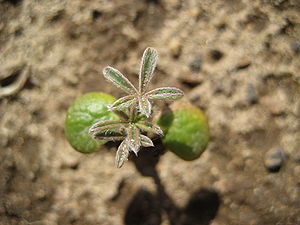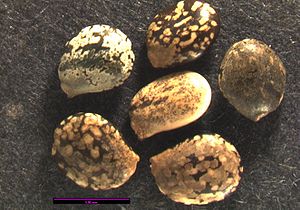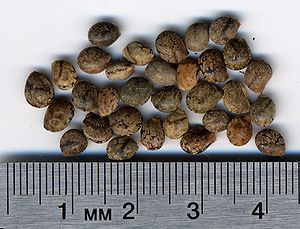Lupinus albicaulis
- Latin Name:
- Family:
- Common Names:
- Synonyms/Misapplications:
- Codon:
Contents
Taxonomy
- Kingdom - Plantae – Plants
- Subkingdom - Tracheobionta – Vascular plants
Superdivision - Spermatophyta – Seed plants
- Division - Magnoliophyta – Flowering plants
- Class - Magnoliopsida – Dicotyledons
- Subclass - Rosidae
- Order - Fabales
- Family - Fabaceae – Pea family
- Genus - Lupinus L. – lupine
- Species - Lupinus albicaulis Douglas – sicklekeel lupine
Synonyms
Lupinus albicaulis Dougl. var. albicaulis
Lupinus falcifer Nutt. ex Torr. & Gray (pro syn.)
Lupinus quercetorum Heller
Lupinus wolfianus C.P. Sm.
Plant Description
General:It is a hairy, erect perennial herb often exceeding a meter in height.
Leaf: Each palmate leaf is made up of 5 to 10 leaflets each up to 7 centimeters long. The inflorescence is up to 44 centimeters long, bearing whorls of flowers each 1 to 1.6 centimeters long.
Flower: The flower is purple to yellowish or whitish in color and has a sickle-shaped keel.
Fruit: The fruit is a silky-hairy legume pod up to 5 centimeters long containing several seeds
Bloom Period
May to July [2]
Distribution
Chiefly west of the Cascades in Washington; Washington south to California. May to July [2]
Habitat
Grasslands and prairies from the lowlands to moderate elevations.[2]
Uses
Good for use in soil stabilization in locations of poor soil fertility, and drought, Lupinus albicaulis has the ability to fix nitrogen and grow rapidly.[3]
Benefits hummingbirds and butterflies (larval host). Low palatability for browsing and grazing animals although small animals use it for cover. Birds eat seeds. Seeds toxic if eaten in large quantities. [4]
Propagation
No stratification needed. Because of seed shatter, should be windrowed a few days before harvest and rolled on tarps to dry. (6 ft roll of paper).
Seed
Seed sample from: 2011
Average Measurement: 5.7 x 4.4 x 2.1
Measurement Range: L: 5 - 6.5, W: 4 - 5, D: 1.5 - 2.5
Features
Color: Seeds are mostly off-white, tan, or gray with darker brown or tan mottling. Speckles tend to be heavier at seed edges leading to a darkened appearance.
Surface: Seeds smooth and glossy with some concave pitting.
Latitudinal Cross Section: elliptical ![]()
Longitudinal Cross Section: elliptical ![]()
Basic Explanations and Assumptions:
The dimensions for the seeds are length x width x depth. The location of the hilum is used as the base of the seed, and the length is measured from hilum to the opposite apex. Where a style is present, the length is measured from the hilum to the bottom of the style. Width is measured at a right angle to the length at the widest part. Depth is measured at a right angle to the intersection of height and width lines.
Measurements included are the mean average for each measurement of ten separate seeds.
All measurements in millimeters unless otherwise noted.
References
- ↑ http://www.pnwflowers.com/flower/lupinus-albicaulis
- ↑ 2.0 2.1 2.2 http://biology.burke.washington.edu/herbarium/imagecollection.php?Genus=Lupinus&Species=albicaulis
- ↑ http://www.sevenoaksnativenursery.com/native-plants/perennials-and-bulbs/lupinus-albicaulis/
- ↑ http://www.wildflower.org/plants/result.php?id_plant=LUAL3




